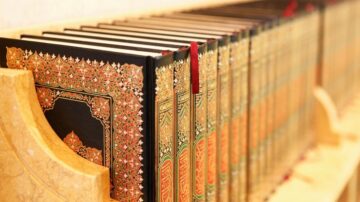Abu `Abdullah Muhammad ibn Yazeed Ar-Reb`ai (also known as Ibn Majah) was born in Qazween (modern-day Bahr Qazween) in 209 AH (824 CE). Qazween at that time was a capital of knowledge abounding with scientific activities and circles of scholars and jurists, just like the other radiant centers of knowledge and civilization, foremost of which are Baghdad, Kufah, Basrah, Marw, and Esfahan. The Abbasid Empire was then at its peak of civilization and power, and Al-Ma’moun was the influential Caliph, who led the Caliphate toward progress and an Islamic-spirited renaissance.
Ibn Majah thus lived the first stages of his life within that scholarly atmosphere. So, he memorized the noble Qur’an and frequented the circles of Hadith scholars that were widely held in Qazween’s mosques, until he learned a lot in this discipline. Then he made his plan for a journey in the pursuit of Hadith, which was a tradition followed by the greatest scholars of Hadith in that era, in compliance with the Prophetic hadiths that encourage the pursuit of knowledge.
Prophet Muhammad (peace and blessings be upon him) said, “Whoever walks in a way to seek knowledge, therein will be led by Allah to a way to Paradise” (Muslim).
Al-Bukhari commenced the section on knowledge in his book of authentic Hadith with a chapter on going out in the pursuit of knowledge. It was mentioned in the beginning of this chapter that Jabir ibn `Abdullah traveled a month’s distance to `Abdullah ibn `Unais for a single hadith!
The journey in search of knowledge was of such great significance to the extent that compilations were written on principles and guidelines that ought to be followed and adhered to by the traveling seeker of knowledge.
His Journey for Knowledge
Ibn Majah set out on his journey in 230 AH (844 CE) at the age of 22 to learn Hadith from scholars. He traveled to Khurasan, Basra, Kufah, Baghdad, Damascus, Makkah, Madinah, and Egypt.
He was instructed by a number of highly knowledgeable scholars, such as Ibrahim ibn Al-Mundhir, Al-Hafiz Al-Halawani Abu Muhammad Hassan ibn `Ali ibn Muhammad Al-Khallal, Al-Hafiz Az-Zubair ibn Bitar, Salamah ibn Shabib, Al-Hafiz Ya`qoub ibn Hamid, Isma`il ibn Mousa Al-Fazari, Harmalah ibn Yahya, and Zuhair ibn Harb.
After an arduous journey that lasted more than 15 years, Ibn Majah turned back to Qazween and settled in it. He spent most of his time writing, classifying, and narrating hadiths. At that time, his fame grew far and wide and seekers of knowledge from everywhere would come to him.
His Works
Ibn Majah gained the trust and respect of his contemporaries. He was deemed one of the greatest imams and scholars of Hadith. The author of At-tadween Fi Tarikh Qazween (Arabic for recording the history of Qazween) said of him, “He is one of the great imams of Muslims; he is excellent and accurate; he enjoys unanimous acceptance.”
Also, Adh-Dhahabi (a reputable Islamic scholar, excelling in knowledge of Hadith, History and others) said about him, “He is an erudite, reliable hafiz[1]
Historians attested to the precedence and excellence of Ibn Majah on account of his vast knowledge and the valuable books and compilations that he left. Most of his works, however, were prone to negligence and carelessness and were consequently lost, along with the treasures of our great heritage.
He wrote a book on Tafseer (interpretation) of the Qur’an, which was described by the famous historian and interpreter of the Qur’an Ibn Kathir in his book Al-Bidayah wa An-Nihayah (Arabic for the beginning and the end) as a rich book. Reference to Ibn Majah’s book on Tafseer was also made by great scholar As-Siouty in his book Al-Itqan Fi `Ulum Al-Qur’an (Arabic for mastering the sciences of the Qur’an).
Ibn Majah also authored a book on history that continued to exist for a long time after his death. Ibn Tahir Al-Maqdesi, an eminent scholar, was reported to have seen this book with a comment on it handwritten by Ja`far ibn Idris (a student of Ibn Majah). Ibn Kathir described it as comprehensive.
Compilation of Sunan
The only surviving book written by Ibn Majah is Sunan. This book has achieved widespread fame and gave him renown and prestigious status among the scholars of Hadith. The book ranks as the fourth book of Sunnah after the three well-known books of Abu Dawud, At-Tirmidhi, and An-Nasa’i. It is also one of six important books of Sunnah that include Sahih of Al-Bukhari and Muslim, besides the aforementioned books. These books are fundamental references of Sunnah.
Before Ibn Majah, the scholars used to refer to only five books of Sunnah; however, after the appearance of Ibn Majah’s book, the scholars came to include his book among the authentic books of Sunnah.
Previously, the scholars of Hadith had different opinions as to which of the following two books should be included within the authentic books of Hadith: Muwatta’ Malik and Sunan Ibn Majah. The erudite scholar of Hadith Abdel-Mu`im An-Nabulsi, who died in 1143 AH (1730 CE), commented on this subject in the introduction to his book Zakha’ir Al-Mawareeth Fi Ad-dalalah `Ala Mawdu` Al-Hadith. He, namely, said,
There was disagreement concerning which should be the sixth book — the scholars belonging to the eastern part of the Muslim land.
By Ahmad Tammam – Translated By Ahmad Al-Gharabawi

